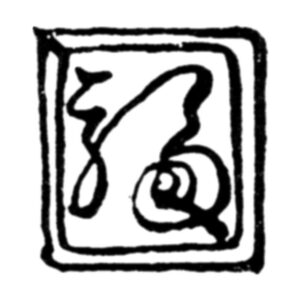
A symbol of good fortune written within a rectangular outline. In China, the Chinese characters for “good fortune” and “longevity” are beloved and often used on ceramics and porcelain, and in Japan they have been imitated since ancient times. In the beginning, it was not intended to be a specific trademark, so there are differences in the outline, such as the single or double lettering. The characters were in seal, square, and grass scripts, and as they were copied over the years, they came to be seen in a thousand different ways. The characteristics of this style can be described in a single word as “heavy lines with spirals at the corners. In 1885, Sakaida Kakiemon of Minamikawara, Hizen Kurata, registered this as his own trademark. The Kakiemon family had also long used a cursive Fukuji written in cursive inside a double square with a spiral-shaped rice field, but since the registration, the Kaku Fukuji mark became exclusive for this purpose, often causing disputes with other potters. In the Taisho era (1912-1926), there was a legal dispute with the Imaizumi family of Arita, which caused controversy in this field, but he later withdrew the lawsuit, apologized to the Kakiemon family, and called himself Imaemon ware. The registered trademark of the Kakufuku mark was owned by the Kakiemon Limited Partnership, but in 1928, Kakiemon withdrew from the company and became independent under the name “Made by Kakiemon,” and the mark became the exclusive property of the limited partnership. Among the rough products of the modern period, there is a Kakufuku Kakufuku Kakufuku female seal that is very similar to Kakufuku, and the cursive style of the female character makes it difficult to distinguish it from Rasenfuku. (History of Kutani Ceramics, Terauchi Shinichi, Shiota Rikizo)



